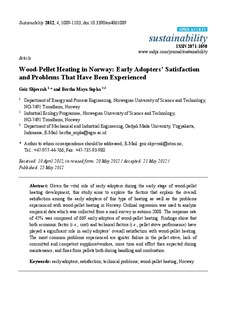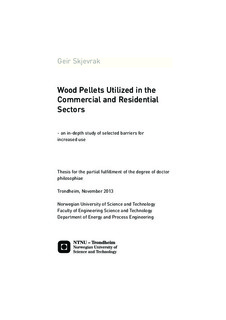| dc.contributor.author | Skjevrak, Geir | nb_NO |
| dc.date.accessioned | 2014-12-19T11:51:38Z | |
| dc.date.available | 2014-12-19T11:51:38Z | |
| dc.date.created | 2014-01-06 | nb_NO |
| dc.date.issued | 2013 | nb_NO |
| dc.identifier | 683854 | nb_NO |
| dc.identifier.isbn | 978-82-471-4781-8 (printed ver.) | nb_NO |
| dc.identifier.isbn | 978-82-471-4782-5 (electronic ver.) | nb_NO |
| dc.identifier.uri | http://hdl.handle.net/11250/235414 | |
| dc.description.abstract | Biomass is an important energy carrier since it is a renewable source and the energy content in the fuel can be stored over time and also generate high temperatures. Bioenergy can be in liquid form, gas-phase or solid. The most common phase is as a solid. Before use, the biomass needs harvesting and refining. Pelletization is one of the most promising solid fuel qualities with a wide range of benefits which are needed before the product can enter the market and compete with more traditional sources of energy like heating oil and electricity.
Despite its benefits, the pellet market still requires development. Several barriers need to be lifted such as understanding the market behavior, finding how bioenergy systems are adapted and what the level of technology is. Pellet feedstock is normally bi-products from sawmills, but increasing demand makes other feedstock alternatives interesting. Pulpwood from pine, straw and husk from agriculture and residue from the furniture industry are examples of new types of feedstock for pellet production. Different feedstocks can bring challenges due to the mechanical properties of the pellet fuel. Also chemical properties can be demanding if the inorganic content in the feedstock is high.
The main objectives of the present work are divided into three selected areas; small scale pellets users in Norway, pretreatment of pure feedstock from pine and manufacturing of low-grade feedstock pellets with additives.
The following research questions were settled for the work: 1) Which factors lead single household owners to choose wood pellet stoves compared to heat pump solutions and direct electrically heated systems? 2) How will existing users of wood pellets stoves choose if they should have any new system? 3) What is the practical experience of existing wood pellet stove users with aspects like the technical properties of fuel, stove or stakeholders? 4) How does extended storage of pine feedstock affect the mechanical pellet quality? 5) How does high and low temperature drying of pine feedstock affect the mechanical pellet quality? 6) How is the mechanical quality properties of pellets affected by the use of different selected additives? 7) Is the low-grade feedstock pellets made with additives combustible in ordinary grate furnaces/boilers? 8) How are the ash melting properties of difficult fuels affected by the use of selected additives?
The research questions are aimed to solve by investigation of market penetration of wood pellet stoves through a survey. Further new pellet feedstocks like pulpwood, agricultural and furniture residues have been produced and tested. Also mixtures with different additives have been produced. The purpose of additives is mechanical fuel quality improvement and increasing the melting point of the ash in the fuel. Finally the new pellet fuel assortments were combusted and tested.
All experiments and data collections performed this work is done in an industrial context. Chipping, grinding and pelletization were performed in ordinary industrial plants. Feedstock samples are collected from ordinary harvesting or side-product processes. Combustion is performed in ordinary furnaces/boilers. All processes mentioned above were set up with necessary measurement equipment. This way of experiment approaches have given good validity of the results from the experiments.
The market investigation work was performed by a questionnaire among 188 random non-wood pellet users and 461 wood pellet users in Norway. The survey reached a response rate of 45 % from the existing wood pellet users. Factors that influence the decision of purchasing a heating system were identified like the age of the consumer, regional constraints in the availability of pellets and also that economic competitiveness is also weak compared to electrical heating. It was also found that pellet stoves need technical improvements to meet the end-user expectations. The ignition, control system, noise and imperfect combustion are examples of technical factors which need improvement.
New pellet feedstocks need treatment prior to the pelletization process. Such process steps are chipping, grinding, storage, drying and possibly the use of additives. In this thesis, several feedstock assortments were manufactured. Pine pulp was stored outside for a year and dried at both high and low temperatures. The high temperature dried material and also stored material resulted in higher energy use for pelletization. There was lower energy consumption for fresh, low temperature dried material. Fresh material was found to have higher durability.
Barley straw, barley husk and residue from furniture contain a larger amount of ash and a higher concentration of problematic ash-forming elements compared to conventional woody biomasses. This causes normally severe ash sintering and slagging which were observed in this study.
Different raw feedstock were pelletized and combusted together with different additives. These additives might have multifunction such as: 1) improve the properties of fuel pellets from the mechanical point of view and 2) abate fuel ash slagging to achieve an efficient and smooth combustion process.
In this work, each raw feedstock was pelletized with different additives in various additive-to-fuel ratios. The influence of additive addition on the pellet production process (i.e., power consumption) and pellet properties (i.e., bulk density, durability and particle density) were investigated. For furniture residue, both sewage sludge and marble sludge improved the durability of the pellets. But when there was a high content of marble, the durability was reduced and the levels of fines increased. Barley straw and barley husk durability were also improved with the lignosulfonate additive. With the marble sludge additive the barley husk durability was increased. Opposite barley straw durability was lowered with marble sludge additive. With combinations of both additives, the positive effect of marble sludge additive for both the barley straw and barley husk was to some extent eliminated.
There are significant differences between the composition and ash chemistry of the formed slags. The slag from wood wastes was dominated by K, Na, Si and Ca, which were completely melted and fused into large blocks. The results from the chemical composition analyses of slag samples suggest intensive formation and fusion of low temperature melting alkali silicates. For the barley straw and barley husk that are rich in Si, K, P and Ca, most of the K reacts with both P and Si in ash residues and forms ash melts containing low temperature melting potassium silicates and phosphates. The ash melts were not transported from the grate area in the furnace and gives thereby initiated and enhanced ash slagging which reduces the operation stability of the furnace.
Lignosulfonate, marble sludge and sewage sludge are proposed as additives to mitigate ash slagging during the combustion of the studied fuels. Marble sludge served as the most efficient additive to eliminate ash slagging during the combustion of pelletized barley straw, barley husk and wood wastes, respectively. The addition of marble sludge led to the formation of high temperature melting calcium-rich alkali silicates and/or phosphates. This process was accompanied by a significant reduction in ash melts and slag formation.
A less pronounced anti-slagging effect was observed from the combustion of lignosulfonate added to barley straw and barley husk pellets. However, the addition of lignosulfonate altered the ash chemistry and promoted the formation of high temperature melting potassium calcium phosphates in ash residues. As result of this, the fraction of ingoing fuel ash that forms slag decreased, and the slags had smaller size and a lower degree of sintering. The addition of sewage sludge slightly reduced the slag formation during the combustion of wood waste pellets. This occurred because sewage sludge contributed to the formation of high temperature melting alkali aluminum silicates. | nb_NO |
| dc.language | eng | nb_NO |
| dc.publisher | Norges teknisk-naturvitenskapelige universitet, Fakultet for ingeniørvitenskap og teknologi, Institutt for energi- og prosessteknikk | nb_NO |
| dc.relation.ispartofseries | Doktoravhandlinger ved NTNU, 1503-8181; 2013:322 | nb_NO |
| dc.relation.haspart | Filbakk, Tore; Skjevrak, Geir; Hoibo, Olav; Dibdiakova, Janka; Jirjis, Raida. The influence of storage and drying methods for Scots pine raw material on mechanical pellet properties and production parameters. Fuel processing technology. (ISSN 0378-3820). 92(5): 871-878, 2011. <a href='http://dx.doi.org/10.1016/j.fuproc.2010.12.001'>10.1016/j.fuproc.2010.12.001</a>. | nb_NO |
| dc.relation.haspart | Skjevrak, Geir; Sopha, Bertha Maya. Wood-Pellet Heating in Norway. Sustainability. (ISSN 2071-1050). 4(6): 1089-1103, 2012. <a href='http://dx.doi.org/10.3390/su4061089'>10.3390/su4061089</a>. | nb_NO |
| dc.relation.haspart | Sopha, Bertha Maya; Klockner, Christian A.; Skjevrak, Geir; Hertwich, Edgar G.. Norwegian households' perception of wood pellet stove compared to air-to-air heat pump and electric heating. Energy Policy. (ISSN 0301-4215). 38(7): 3744-3754, 2010. <a href='http://dx.doi.org/10.1016/j.enpol.2010.02.052'>10.1016/j.enpol.2010.02.052</a>. | nb_NO |
| dc.relation.haspart | Skjevrak, Geir; Wang, Liang; Tore, Filbakk; Nielsen, Henrik Kofoed; Hustad, Johan E.. Effects of lignosulfonate and marble sludge additives on the mechanical properties of pellets of barley husk and straw fuel pellets.. . | nb_NO |
| dc.relation.haspart | Skjevrak, Geir; Liang, Wang; Michael, Becidan; Øyvind, Skreiberg. Slagging Characteristics during Combustion of Biomass Pellets and Effect of Additives.. . | nb_NO |
| dc.relation.haspart | Skjevrak, Geir; Wang, Liang; Skreiberg, Øyvind; Becidan, Michael. Pelletizing and Combustion Behaviors of Wood Waste with Additives Mixing. 2012 ASIA-PACIFIC POWER AND ENERGY ENGINEERING CONFERENCE (APPEEC), 2012. <a href='http://dx.doi.org/10.1109/APPEEC.2012.6306992'>10.1109/APPEEC.2012.6306992</a>. | nb_NO |
| dc.relation.haspart | Wang, Liang; Skjevrak, Geir; Hustad, Johan E.; Grønli, Morten G.. Effects of Sewage Sludge and Marble Sludge Addition on Slag Characteristics during Wood Waste Pellets Combustion. Energy & Fuels. (ISSN 0887-0624). 25(12): 5775-5785, 2011. <a href='http://dx.doi.org/10.1021/ef2007722'>10.1021/ef2007722</a>. | nb_NO |
| dc.title | Wood Pellets Utilized in the Commercial and Residential Sectors: - an in-depth study of selected barriers for increased use | nb_NO |
| dc.type | Doctoral thesis | nb_NO |
| dc.contributor.department | Norges teknisk-naturvitenskapelige universitet, Fakultet for ingeniørvitenskap og teknologi, Institutt for energi- og prosessteknikk | nb_NO |
| dc.description.degree | PhD i energi- og prosessteknikk | nb_NO |
| dc.description.degree | PhD in Energy and Process Engineering | en_GB |


